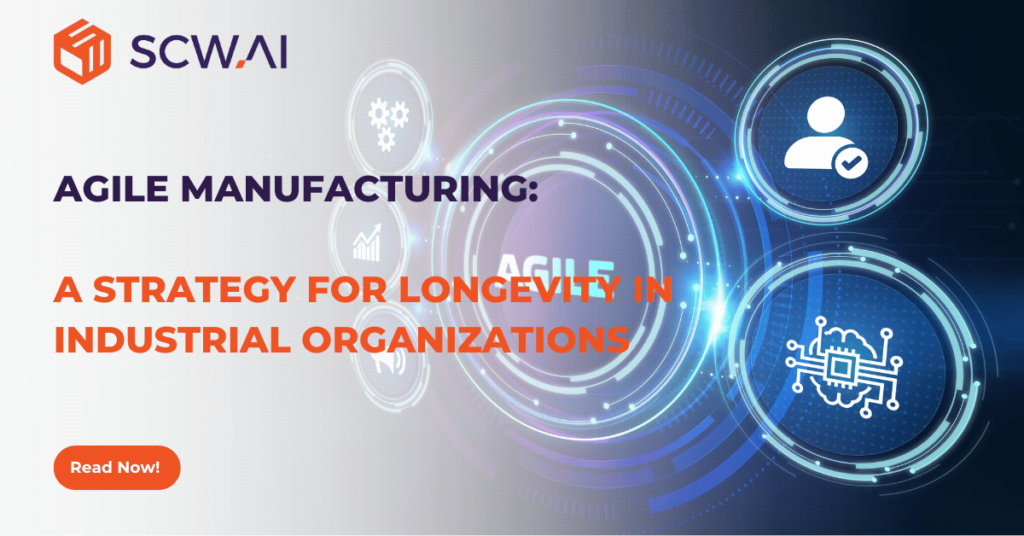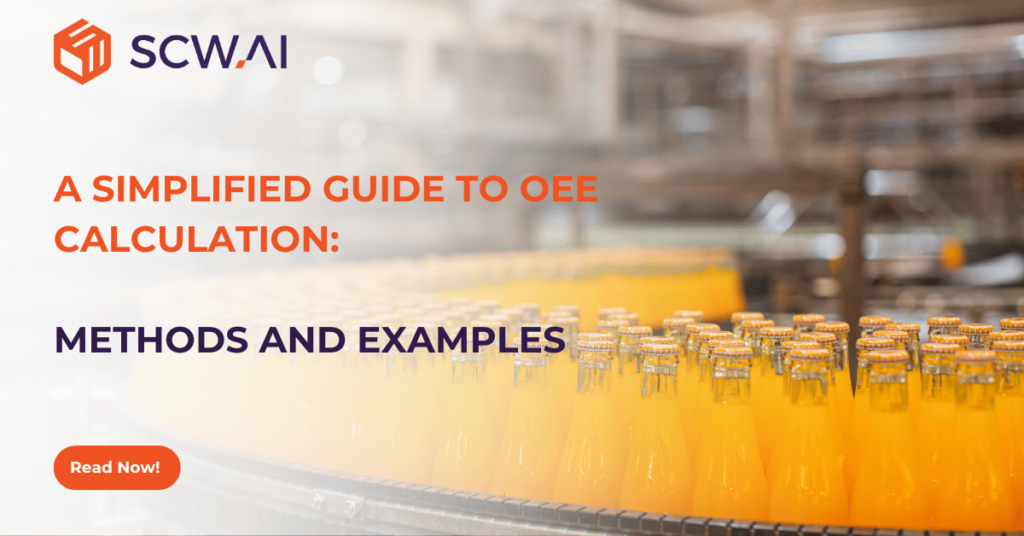Paperless manufacturing revolutionizes the way factories manage, coordinate, and report production activities by utilizing digital tools. Digitizing forms is an effective strategy for streamlined work order management, maintaining quality standards, and ensuring compliance. Despite the availability of paperless manufacturing solutions, the prevailing method of recording production activities still relies on paper-based documents, which come with inherent drawbacks:
- The data entry process consumes up to 30% of operator time, particularly in industries like pharmaceuticals, as reported by McKinsey.
- Data integrity, quality, and auditability are compromised.
- The environmental impact of paper production and disposal is significant. For instance, in 2024 alone, a forest area larger than the size of Portugal is projected to be cut down for paper production.
This article seeks to offer manufacturing leaders a contemporary perspective on their documentation practices. We begin by providing a detailed definition of paperless manufacturing, followed by an exploration of nine key benefits associated with making the transformation. Finally, we conclude with best practices to guide manufacturers towards achieving a paperless factory, along with insights into SCW.AI solutions that can facilitate this transformative process.

What is Paperless Manufacturing?
Paperless manufacturing is the practice of employing software and systems like digital forms, digital logbooks, and digital batch records to oversee and document manufacturing processes, thereby eliminating the need for traditional paper-based methods. This digital approach includes the quality assessments, and compliance documents into digital formats, streamlining operations and enhancing efficiency.
Illustrated below is a demonstration of how our system streamlines task management and segregation of duties within pharmaceutical manufacturing. In this scenario, a user with the Production Manager role is promptly notified of pending approvals for logs that require their attention.
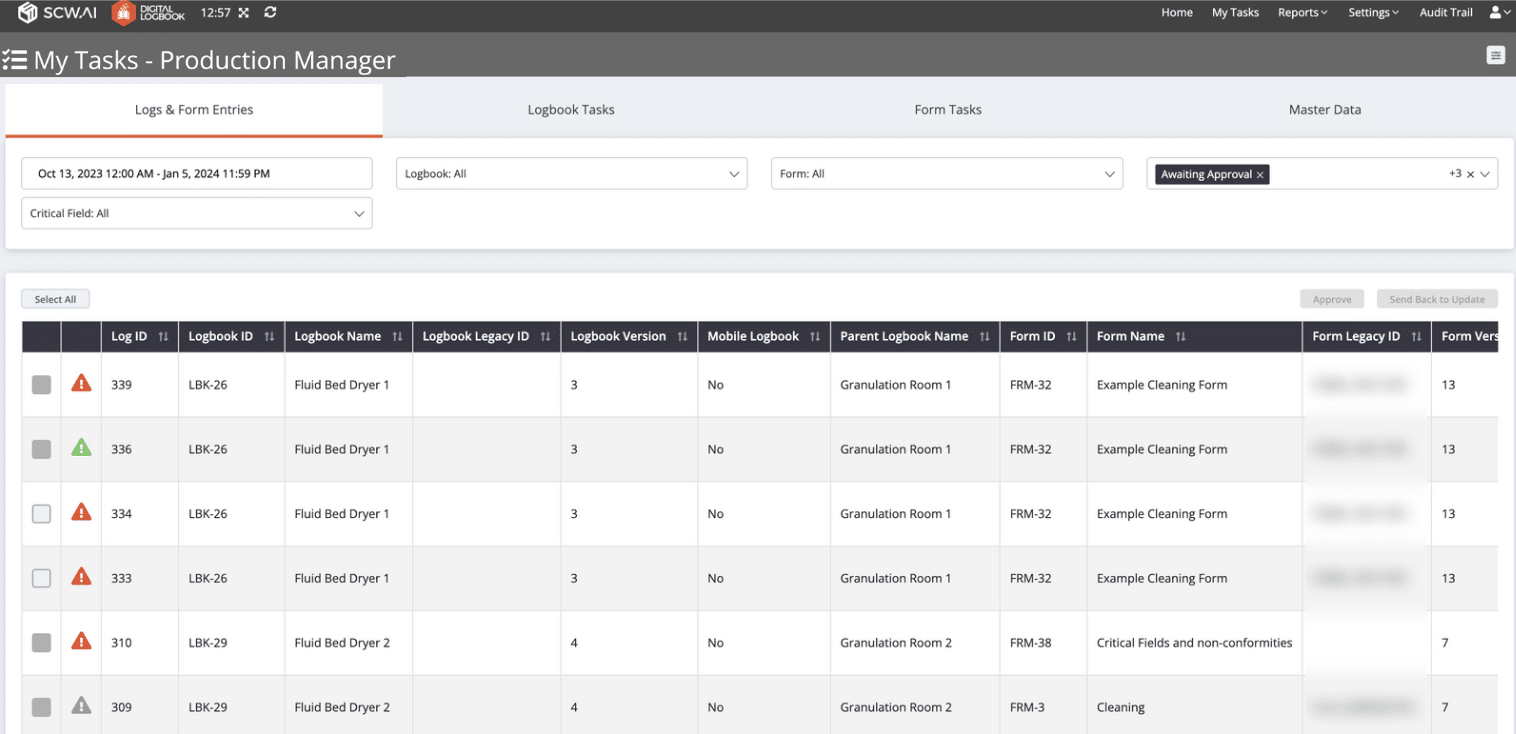
9 Benefits of Building a Paperless Factory
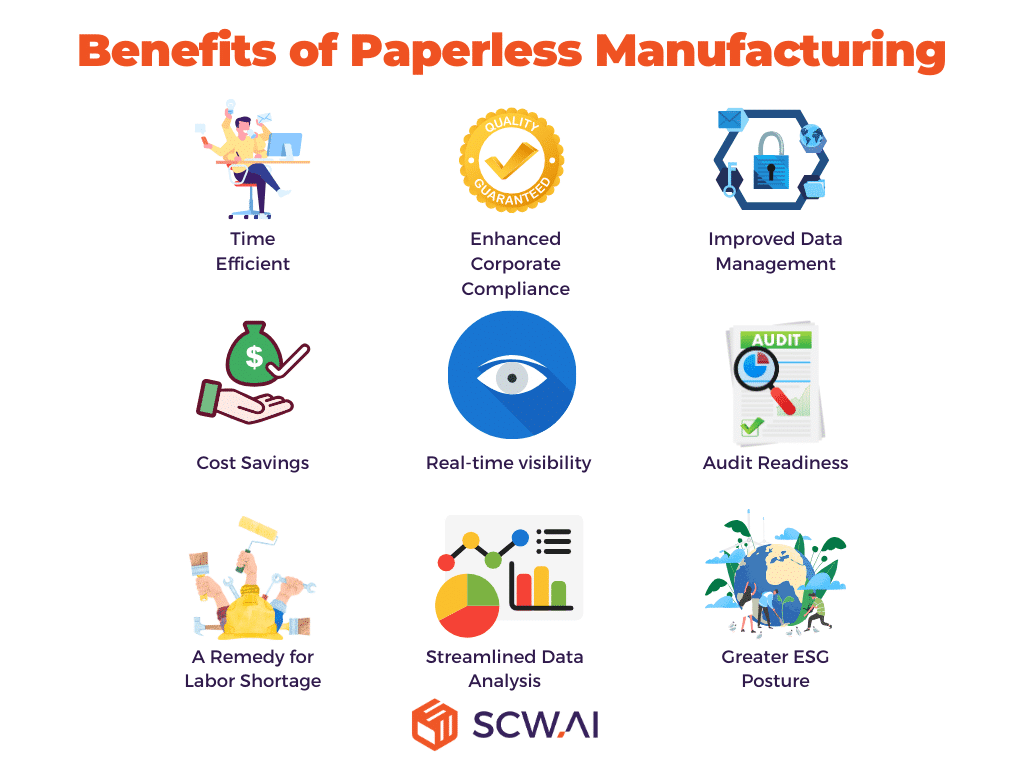
1. Reduction in Data Entry Time and Errors
According to our case studies, paperless manufacturing systems significantly reduce the time operators spend on manual data entry by approximately 50% to 85%, depending on the industry and the specific tasks being documented. This efficiency gain can be attributed to several factors:
- Identifying high time spent areas and avoiding redundant entries with smart built forms can reduce time spent.
- Smart forms, features of mandatory fields, automated calculation capabilities, and conditional workflows, can decrease human errors significantly.
- Paperless forms can integrate data from a company’s existing ERP and MES systems, as well as from IoT and PLC integrations, thereby automating portions of the data entry process.
Furthermore, paperless manufacturing significantly mitigates the risk of erroneous data entry through automated calculations, by issuing automatic alerts for incorrect data inputs, and by auto-populating some fields. The video below for instance demonstrates how paperless factories have notably improved data quality by automatically calculating summation of raw material kilograms. At the first attempt the user receives an alert regarding deviation since the total amount is conditioned to not to be less than 500 kilograms.
2. Enhanced Corporate Compliance
Paperless manufacturing software enhances the tracking and management of quality control processes. It enables real-time identification of issues and real-time information of deviation, with users receiving notifications on wearable devices, smartphones, tablets, and computers. Consequently, quality deviations can be addressed swiftly and efficiently.
3. Improved Data Integrity and Security
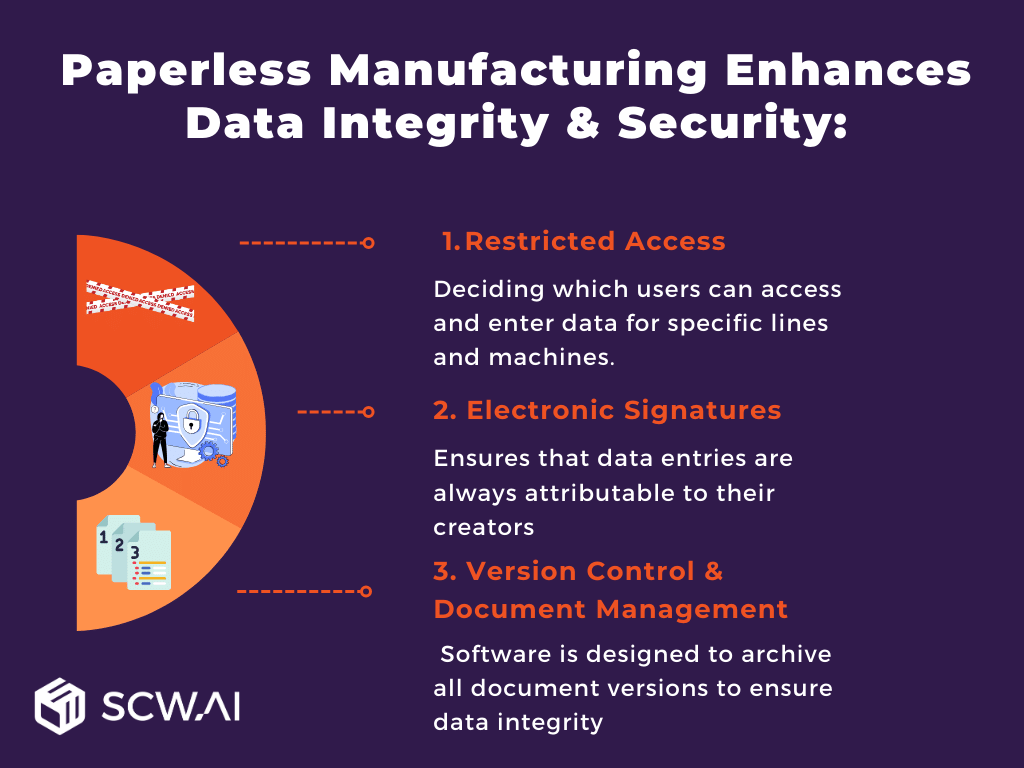
Paperless manufacturing solutions enhance data integrity and security through several key features:
- Restricted Access: The software’s global administrators can control and manage user permissions, according to segregation of duties, dictating which users can access and enter data for specific lines and machines. This approach aligns with the zero-trust architecture, a cybersecurity best practice that assumes no entity within or outside the network is trustworthy without verification.
- Electronic Signatures: The integration of e-signature capabilities ensures that data entries are always attributable to their creators, enhancing traceability and accountability across operations. This is also an integral part of FDA 21 CFR Part 11.
- Version Control and Document Management: With a built in document management system (DMS), the software allows for the systematic organization, storage, and retrieval of critical documents such as Logbooks, Forms, Batch Records, and others. Meanwhile, version control mechanisms maintain a comprehensive history of document revisions, ensuring that the most current and approved version is readily accessible while preserving a clear audit trail of changes.
4. Cost Savings
Eliminating paper from the manufacturing process results in direct cost savings. These include reductions in expenses related to paper purchase, printing, and storage, as well as indirect savings from improved efficiency and reduced error rates.
As stated earlier in the article, in certain sectors such as pharmaceutical manufacturing, data entry can consume up to 30% of an operator’s time. From this standpoint, the savings generated indirectly may surpass those achieved directly.
5. Real-time Visibility and Management
Paperless manufacturing systems provide stakeholders with real-time visibility into the production process, enabling better decision-making and more agile responses to any manufacturing challenges.
For instance, executives can monitor operators in real time, tracking their activities such as when they check into a specific line, complete a particular work order, or finish specific tasks like line cleaning or setup.
6. Audit Readiness
A comprehensive digital audit trail facilitates easier management, searching, and retrieval, streamlining the audit process. For instance, auditors can effortlessly review documents from a specific line and date with just a few clicks.
It is crucial to recognize that paperless factory solutions vary in their data integrity capabilities. Therefore, for audit readiness and enhanced corporate compliance, manufacturers should choose their paperless manufacturing provider by considering their industry’s compliance expectations. For example, SCW.AI’s Digital Logbook is an FDA 21 CFR Part 11-compliant paperless quality solution that adheres to ALCOA+ data integrity principles (See Figure Below), specifically tailored for pharmaceutical manufacturers.
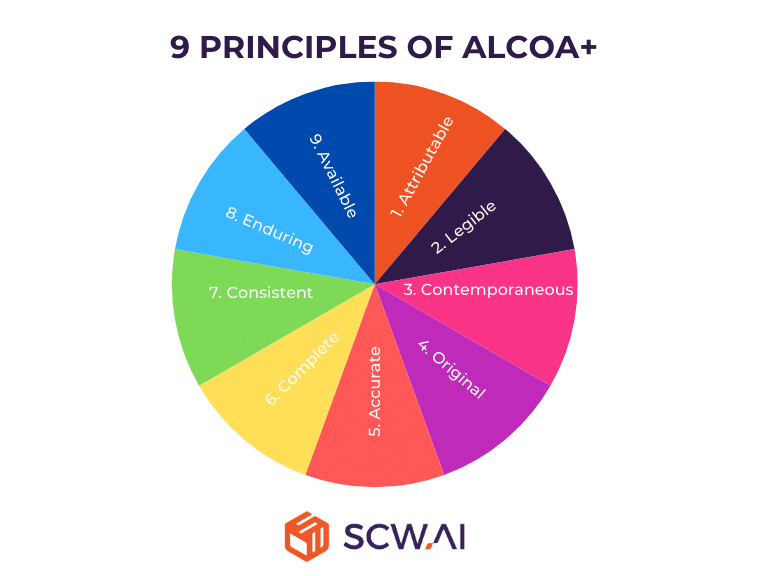
7. A Remedy for Labor Shortage
According to the US Chamber of Commerce, there are 600,000 unfilled job openings in the US manufacturing industry, highlighting a labor shortage issue. In such an environment it is crucial to maximize return of labor by letting them focus on value added tasks rather than wasting so much time on tedious documentation related tasks.
8. More Effective Data Analysis
Digital forms streamline the data analysis process from logbooks, forms, and batch records, as production activities are recorded in a centralized location. The system enables supervisors, managers, and QA to effortlessly monitor generic reports or generate custom reports for specific time intervals. For instance, a manager can quickly assess the number of logs within a certain area from the previous year in just a few seconds.
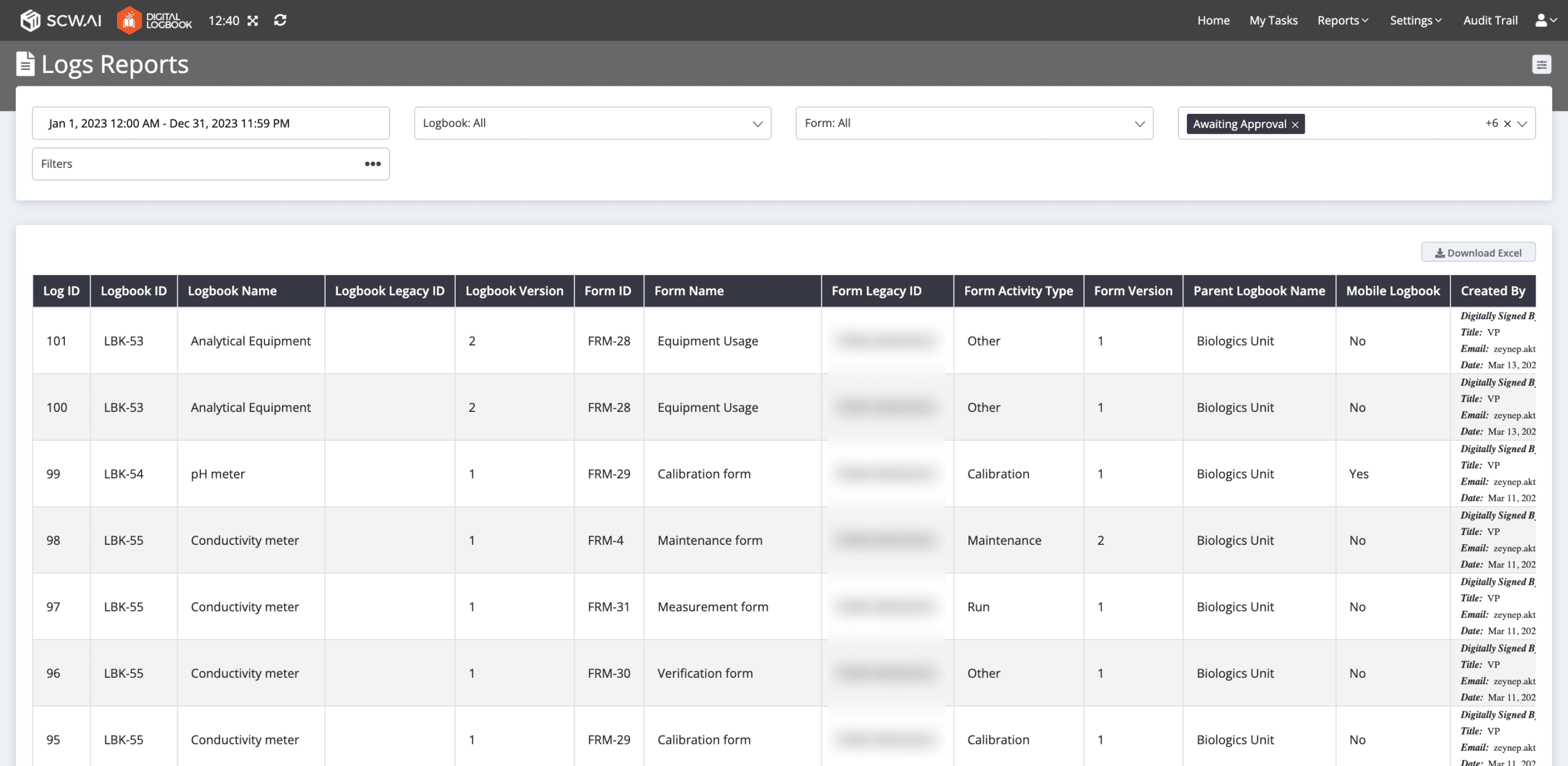
9. Greater ESG Score
Paperless manufacturing is a strategic initiative for businesses to reduce their environmental impact, proactively comply with upcoming sustainability regulations like CSRD, and enhance brand reputation for attracting and retaining skilled workers and ensuring client satisfaction through a stronger ESG stance. Because paper production and disposal entail various environmental costs, such as:
- Deforestation: In 2024 alone, approximately 112,000 square kilometers of forests are projected to be cut down for paper production. To provide perspective, this area is larger than the entire countries of Portugal or Hungary and almost as large as the state of Pennsylvania.
- Water Usage: In 2024, paper production is projected to consume over a billion liters of water, an amount equivalent to filling 500 Olympic-sized swimming pools.
- Waste: With the paper wasted annually, we could construct a 12-foot-high wall extending from New York to California.
3 Steps to Go Paperless in Manufacturing
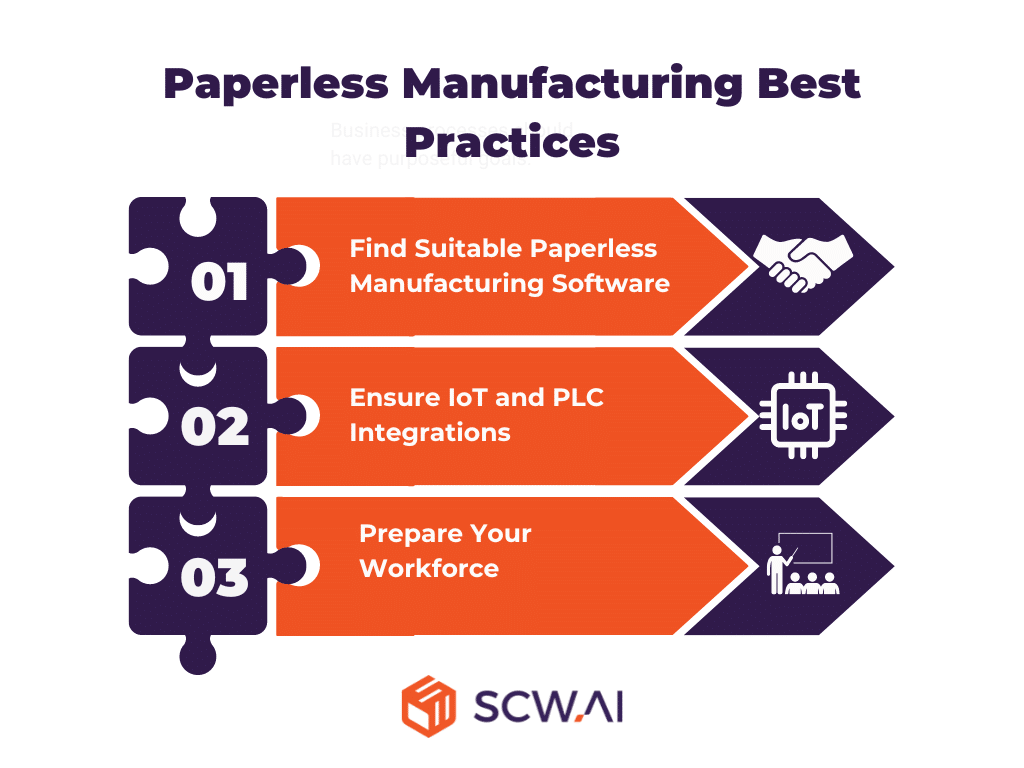
1. Find Suitable Paperless Manufacturing Software for Your Business
Selecting the appropriate paperless manufacturing software is a critical first step in transitioning to a digital-centric factory. Your chosen software should align with your specific industry needs and compliance expectations. Also, consider factors such as user-friendliness, scalability, price and integration capabilities with existing ERP and MES systems.
2. Streamlining Operations with IoT, ERP and LIMS Integrations
To fully leverage the benefits of paperless manufacturing, integrate IoT and PLC (Programmable Logic Controllers) systems into your digital framework. This automation ensures seamless data collection, allowing real-time monitoring and analysis of production activities. Integration with ERP, MES and LIMS systems further enhances the automated and real-time data entry.
In this manner, manufacturers decrease the labor time for data entry as well as the likelihood of data entry errors.
3. Change Management
Preparing your workforce for the transition to a paperless environment is crucial for successful implementation. Provide comprehensive training on the new software and digital tools, emphasizing their user-friendly features. Highlight the benefits of the shift, such as reduced data entry time, enhanced quality control, and improved work visibility. Emphasize the positive impact on job satisfaction and overall workplace efficiency to garner support from employees.
Paperless Manufacturing Solutions of SCW.AI
SCW.AI facilitates the transition to paperless factories through cloud based Digital Forms and Digital Logbooks. GMP compliant Digital Logbook is tailored for FDA-regulated industries, particularly in pharmaceuticals, offering features such as:
- User authentication
- E-signatures
- Adherence to ALCOA+ data integrity requirements
- Smart built forms
- Deviation highlighting
- Version control
- Integration with IoT, PLC, MES, ERP, and LIMS
- Notification capabilities, and more.
To explore SCW.AI’s Digital Factory Platform and paperless factory solutions, book a demo now!
